Starting a home decor blog is a great way to channel your passion for interior decorating – and earn some cash in the process.
With the right approach, home decor blogging can be a lucrative endeavor. Take it from us – we’ve built many profitable blogs, including one in the home niche. Here’s a small sample of the earnings these blogs have generated:

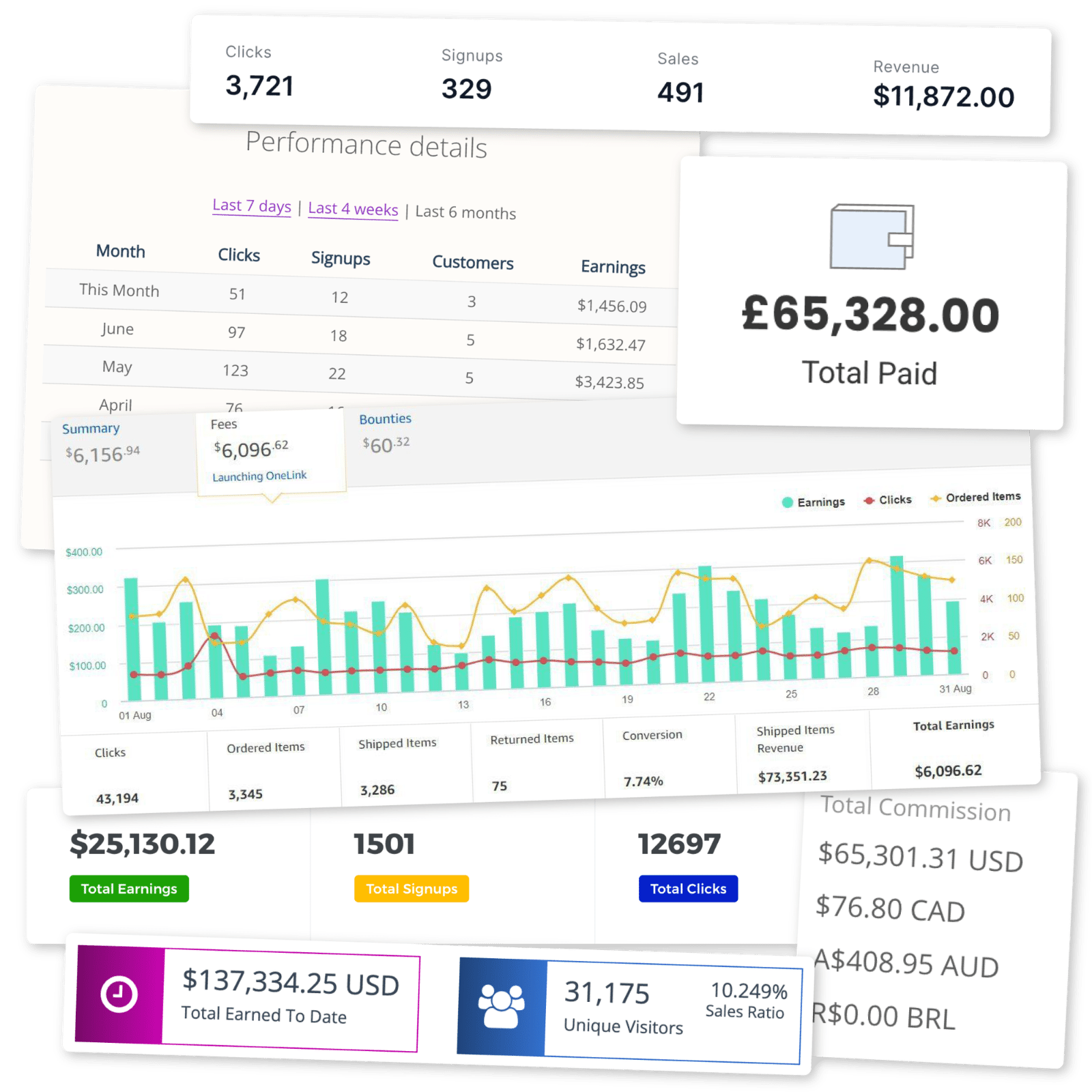
To help you match our success, we’ve created this 10-step guide to starting a home decor blog that gets visitors and earns money.
Why Start a Home Decor Blog
Whether you are a first-time homeowner or a seasoned decorator, there are plenty of good reasons to start your own home decor blog.
If you enjoy home decor, starting a blog gives you the perfect excuse to try out new ideas in your decorating projects. You can also stay current with decorating trends while building a community and connecting with other decor enthusiasts. How fun does that sound?
And, of course, starting a home decor blog allows you to turn your hobby into an income stream by promoting affiliate offers, running advertising on your site, or even selling your own home decor products on sites like Etsy. In fact, our affiliate marketing statistics show that the average blog in the home niche earns more than $5,000 per month.
Examples of Successful Home Decor Blogs
As you start your home decor blog, it helps to look at what successful decor bloggers are doing. Here are three examples you can learn from:

Centsational Style
Centsational Style focuses on low-budget home decor. They’ve done a great job of identifying their sub-niche and connecting with their audience.

The Nester
The Nester is more of a general decor blog. Even though this site doesn’t have a tight focus, they’re on-point regarding the types of visuals and written content decorators love. There’s a lot to learn here!
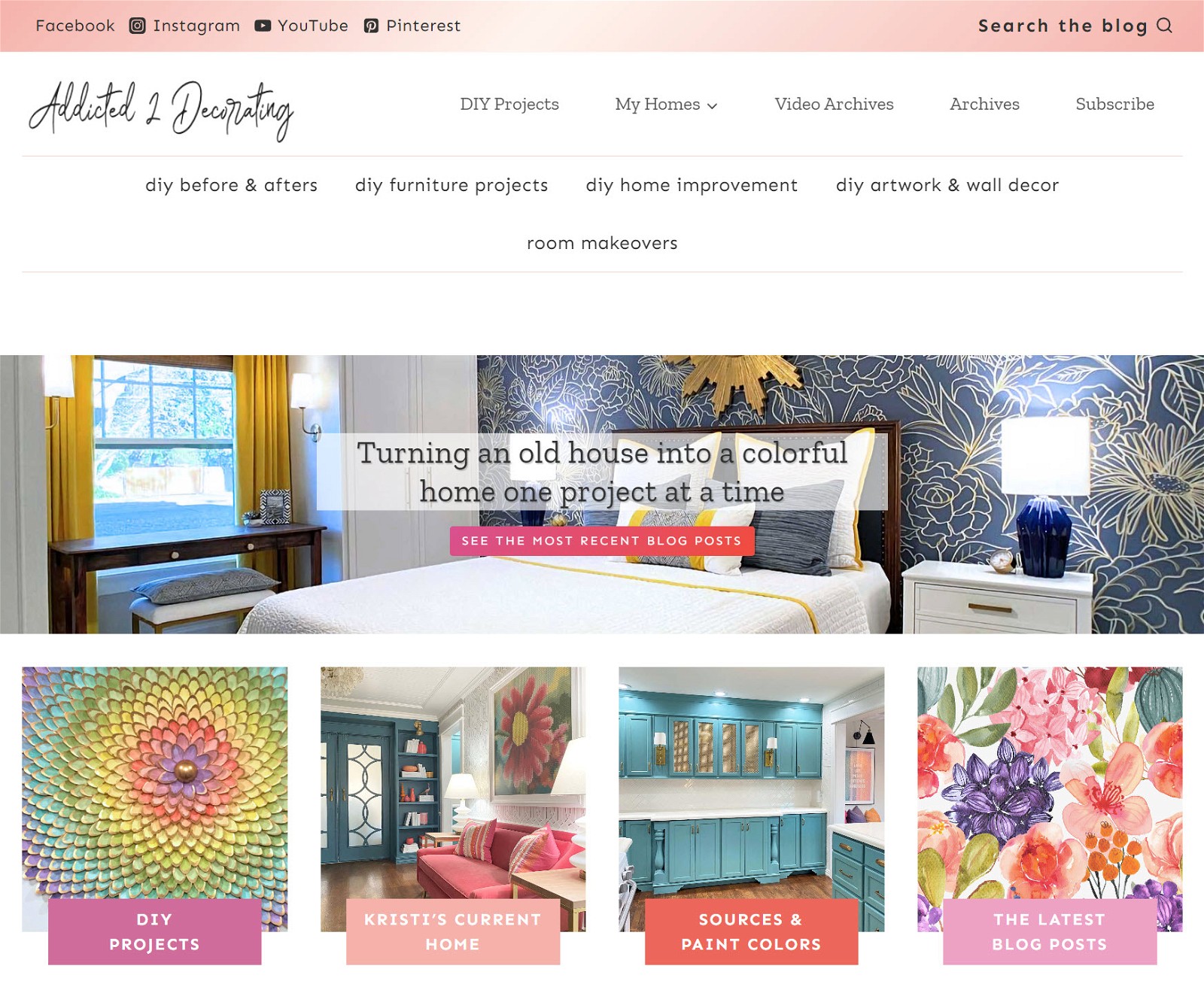
Addicted 2 Decorating
Addicted 2 Decorating is all about do-it-yourself decor projects. It appeals directly to homeowners and other decorators who want to roll up their sleeves and get things done.
How To Start a Home Decor Blog in 10 Steps
Here’s your 10-step blueprint for creating a profitable home decor blog you can be proud of.
1 Narrow Down Your Home Decor Niche
You might be tempted to start writing about anything and everything related to home decor, but it’s important that your blog has a definite focus.
Home decor is a very broad niche, and to build a successful blog in this space, you need to choose a specific sub-niche to focus on. This makes connecting with your target audience and building a following easier.
For example, readers looking for information about affordable home decor want a blog focused on decorating without breaking the bank.
They won’t care about posts that cover the latest high-society decor or expensive antique furniture, and they’d have a harder time connecting with blogs that discuss these topics in addition to affordable decor.
The home decor niche is also quite competitive, with many dedicated bloggers writing about their passion for free. Niching down makes it easier to compete and is the best path for building a profitable blog.
To pick your sub-niche, start by considering which parts of decor excite you the most. Your passion will shine through in your content, which can result in higher-quality blog posts that help keep your audience engaged.
Here are some examples of decor sub-niches that you might consider for your blog:
- DIY Decor: How-to guides for completing your own decorating projects.
- Rustic Decor: Decorating ideas with a rustic flair – primitive furniture, antique kitchenware, handmade curtains, etc.
- Affordable Home Decor: Tips for decorating on a budget, including where to find bargains, affordable substitutions, etc.
- Tiny House Decor: Ideas about making a tiny house stylish without overwhelming the small space.
- Exterior Decor: Focus on outdoor decor – lawn decorations, shutters and trim painting, accent lights, gazebos, etc.
- Apartment Decor: Articles about how to make an apartment space inviting and personalized.
Passion for your home decorating blog niche is a great starting point, but it isn’t the only thing to consider. You also need to look at this from a business perspective. Can you build a following and make money in the sub-niche you’re considering?
The best way to determine if a sub-niche will work is to see if other blogs are already having success covering that topic.
Here’s our preferred strategy for finding home decor sub-niches with a history of blogging success:
Make a list of successful blogs in each home decor niche you’re considering. You can find these with a blog aggregator like Detailed, searching Google for keywords you might write about, or plugging a website into the “Organic Competitors” tool on Ahrefs to find similar websites.
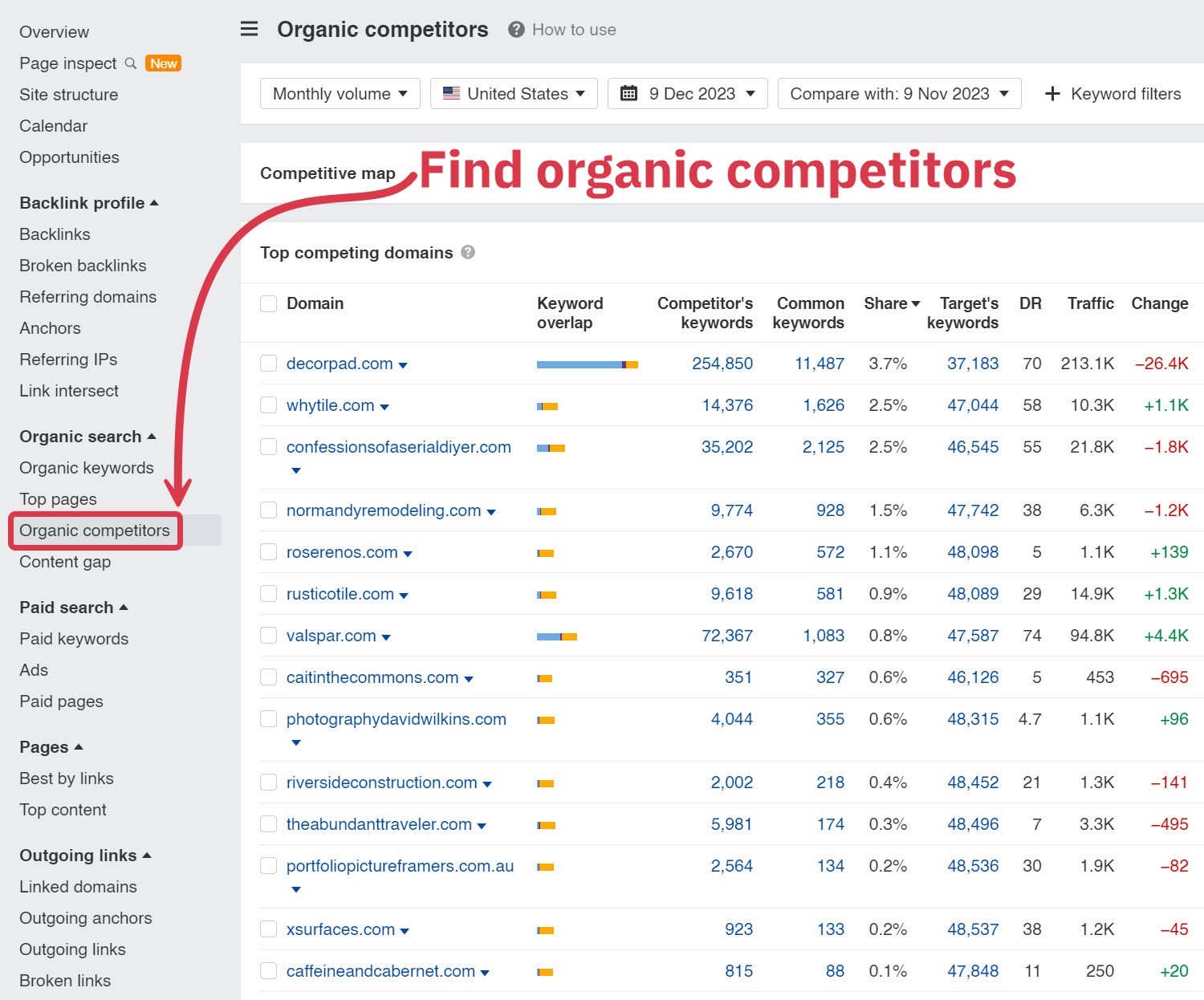
Check traffic levels. High traffic levels are a good indicator of how successful a home decor blog is. You can check the traffic for the blogs you identified above by signing up for a free trial of SE Ranking and analyzing each site in the Competitive Research section.

Compare prospective sub-niches with Google Trends. Google Trends is a great tool for helping you compare the relative traffic of multiple niches if you’re having trouble deciding on just one.
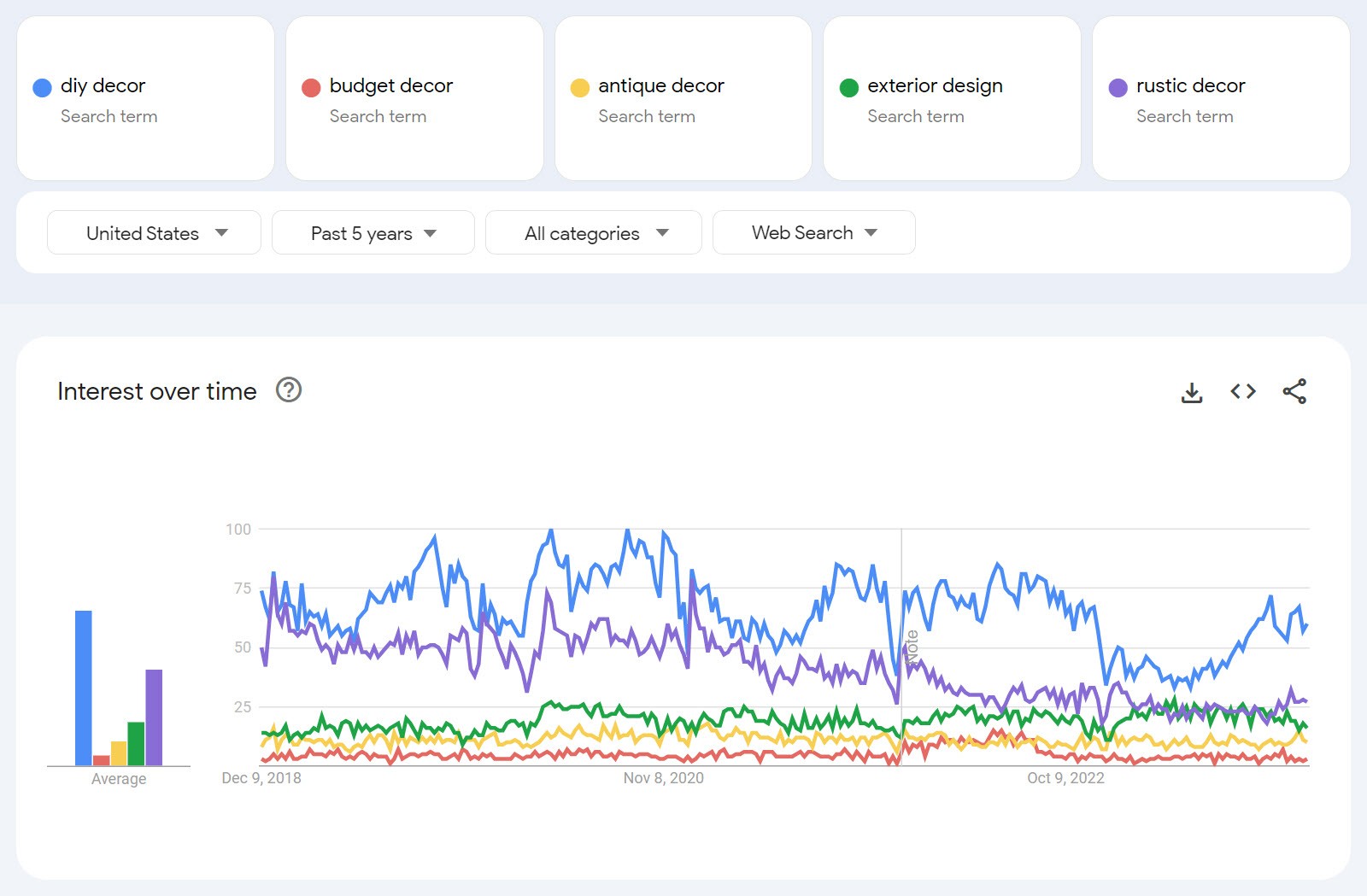
If you’re still stuck, watch our comprehensive YouTube video for more guidance on selecting a niche:
Once you’ve collected the necessary information, take a day or two to think about your sub-niche.
However, try not to get weighed down by the decision. Choosing something and moving forward is better than getting bogged down in endless analysis.
2 Choose a Blogging Platform
Now that you’ve chosen a sub-niche, it’s time to pick a platform for your blog.
A blogging platform is simply a service or suite of software that bloggers use to publish, edit, and manage content on the web.
Some free options include social blogging platforms like Medium and Blogger.
But those free platforms come with some significant downsides:
- They’re hard to monetize.
- They often limit the types of content you can post.
- You can’t fully customize the design and user experience.
If you want full control over your blog and nearly limitless income potential, building your own website is the smartest option.
Here are some of the advantages that a self-hosted blog offers over all other blogging platforms:
- It’s much easier to earn money through affiliate products, display ads, and other monetization strategies with your own blog.
- No one can shut down your website or delete your content.
- You can post whatever type of content you want.
- You have full control over the design and user experience of your blog.
- You can use search engine optimization (SEO) to drive traffic by targeting relevant keywords.
- You can build an email list as a solid, consistent traffic source and a direct pipeline for product promotion.
Many bloggers have made six figures hosting their blogs on their own websites. That wouldn’t have been possible if they chose other platforms.
WordPress is the best platform for building a website – specifically, the free, self-hosted version at WordPress.org (not WordPress.com).

WordPress is free and simple to use, and there are thousands of plugins and themes that let you set up your blog just the way you want it.
Although WordPress is the best choice for most bloggers, it’s not the only game in town.
3 Choose Your Domain Name
Now that you know what platform you’re going to use for your new home decor blog, you need a domain name.
A domain name is the unique web address for your blog. It includes the name of the site and the domain extension, like .com or .net. The domain name is part of the URL people will use to access your site.

Your domain name is the foundation of your brand, so take time and care to choose a good one.
Here are some tips to help you pick the right domain name for your new site:
- Choose a .com domain if possible. It’s the most trusted and familiar extension for most users. See our list of .com alternatives for other possibilities.
- Match it to your niche. Make sure your domain name fits the sub-niche you chose. For example, pennydecorating.com would be a good choice for a thrifty decor blog.
- Keep it broad. Don’t pigeonhole your blog into a very narrow topic. Even if you want to start blogging about a small corner of the home decor niche, you may want to expand your focus once you’re more established.
- Keep it short. Short domain names are easier to remember and type. Try to limit your domain to 3 words or less.
- Make sure it’s not trademarked. Run your domain name ideas through the USPTO site to ensure no one else owns the name.
If you’re having trouble choosing a domain name, use our AI domain generator Brandsnap to find a great name that’s available for purchase.
Once you’ve picked a domain, you must buy it from a domain registrar. You can usually get one on Namecheap for around $10.
4 Buy Web Hosting
Now that you have a domain name, you need to choose a web hosting provider.
A web host is a service that provides the servers and infrastructure to store, manage, and serve your WordPress website to visitors on the net.
Many sites start off using a popular hosting option like Bluehost because it’s inexpensive.
However, we recommend you pick a more robust host like Siteground. It offers superior speed, reliability, and support – and is only slightly more expensive.
Here’s a quick step-by-step guide on getting set up with Siteground hosting:
Step 1: Go to Siteground’s WordPress hosting page.
Step 2: Pick the StartUp plan since it’s the least expensive and has everything you need. It’s perfect for a new blog, but note that the price increases after the first year.

Step 3: Select “I already have a Domain” and enter your domain name. (Unless you didn’t get one from Namecheap):

Step 4: Fill in your account and location details:

Step 5: Add payment info and choose the subscription duration. The 12-month option is usually the best deal.

Step 6: You don’t need the extra services for a new blog, so you can skip them for now.
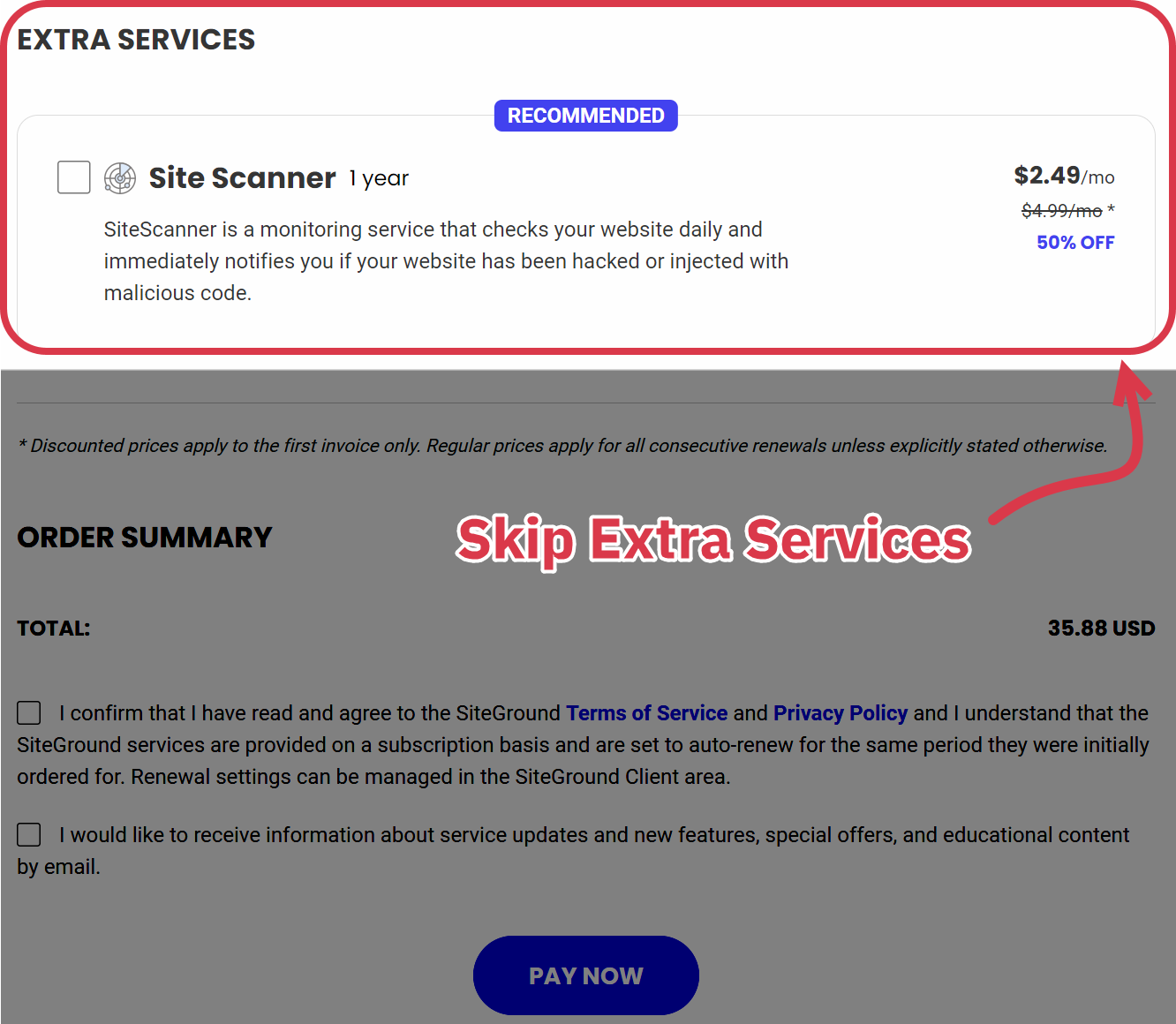
Step 7: Point your domain to Siteground. If you bought your domain from Namecheap (or another registrar), you need to change the DNS settings to point to Siteground. Siteground support can help with this.
You’re all set! Your new home decor blog officially has a host.
5 Choose a Theme for Your Home Decor Blog
With hosting in place, the next step is to set up your WordPress blog and choose a theme.
A WordPress theme is the visual framework that gives your blog structure and design.
Make sure your choices complement the sub-niche of your blog and blog brand. For example, many successful home decor sites use a clean theme with lots of white space and big, bold pictures.
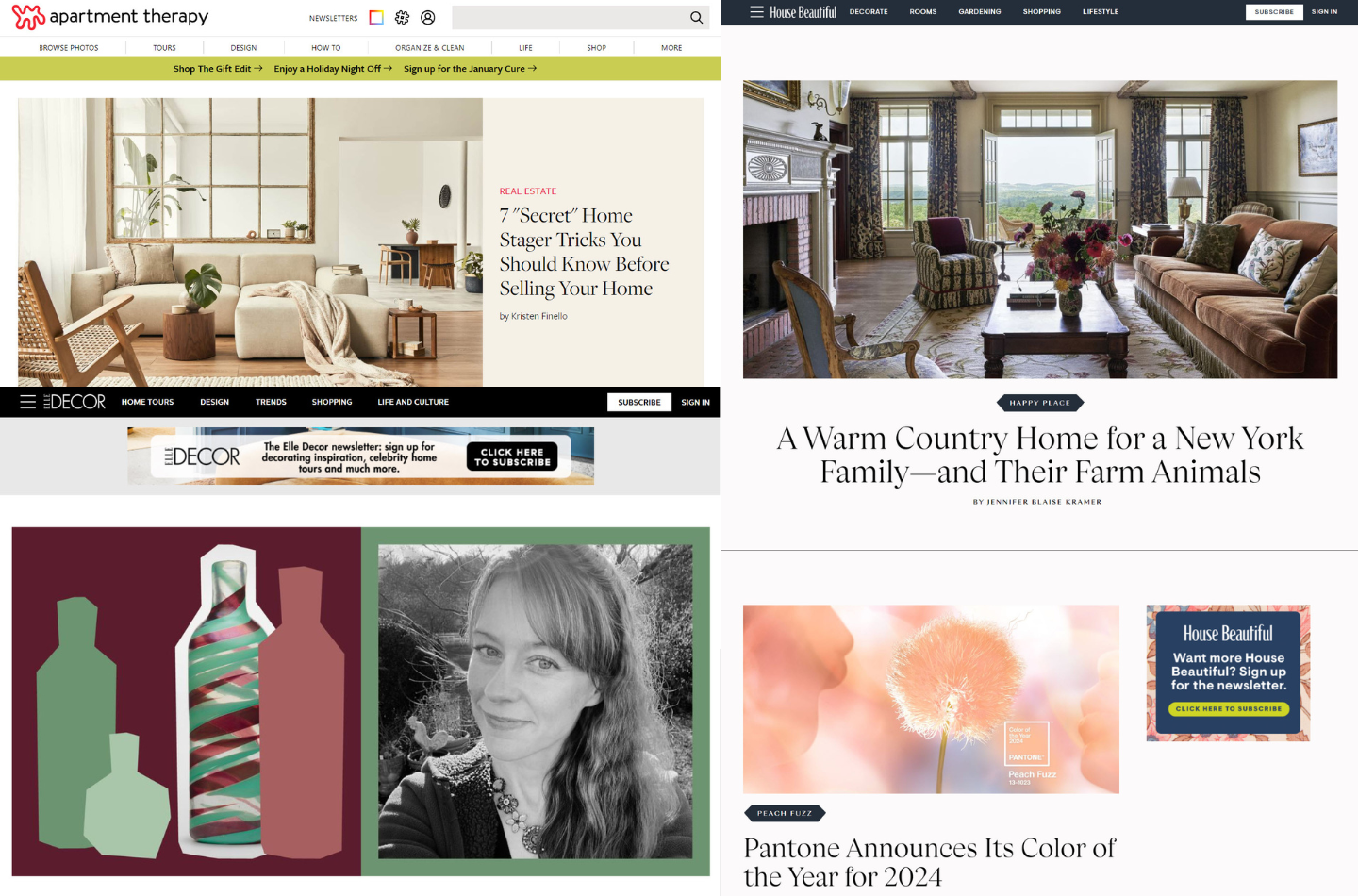
You can choose either a free theme or a premium paid theme.
It’s okay to start with a free theme, but if you do, I advise picking one that allows you to upgrade to a paid plan. Many free themes work fine for a new blog but have limitations that can slow down your growth as you get rolling.
We recommend Astra, Kadence, and GeneratePress as solid “freemium” themes for new blogs:
Each of these themes has a large template library that lets you get a solid layout in place quickly, even if you don’t have much in the way of design skills. They also have free versions that let you get a feel for them before purchasing.
Once you have a theme, you need to install it on your WordPress site. Here are the step-by-step instructions:
Step 1: Go to your WordPress dashboard.
Step 2: Go to the left sidebar and select Appearance > Themes
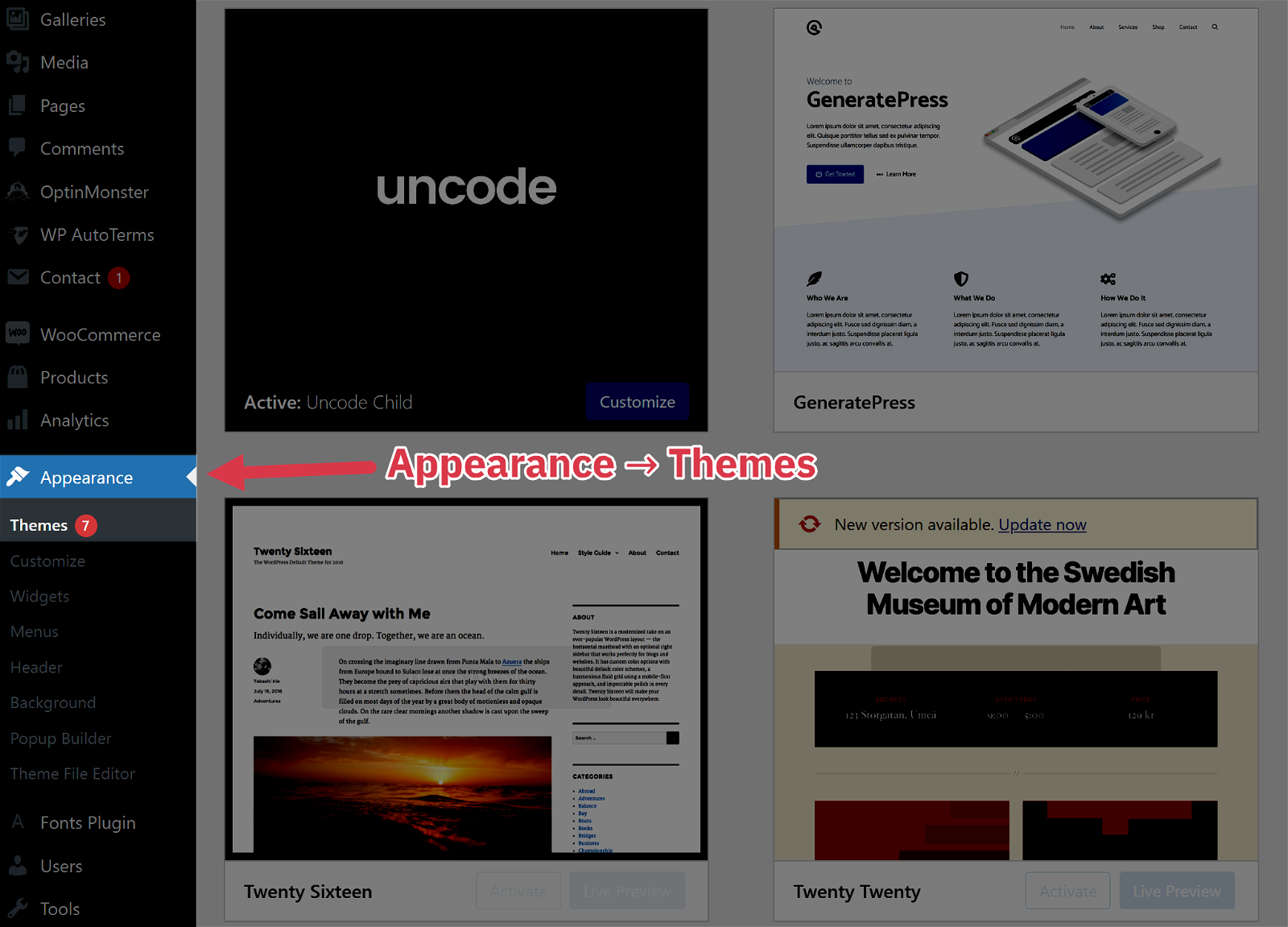
Step 3: Click “Add New”
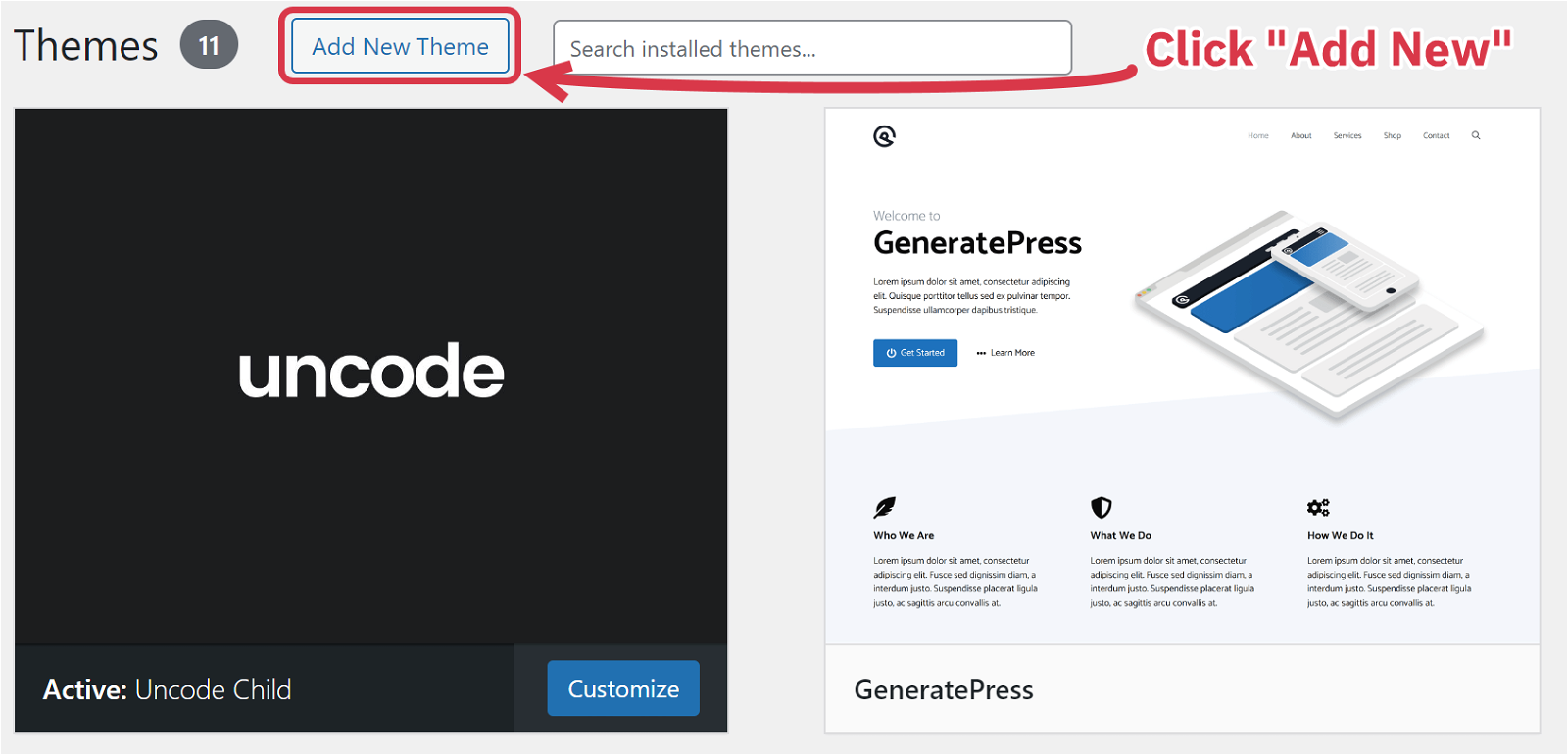
Step 4: Search for your theme and click “Activate.”
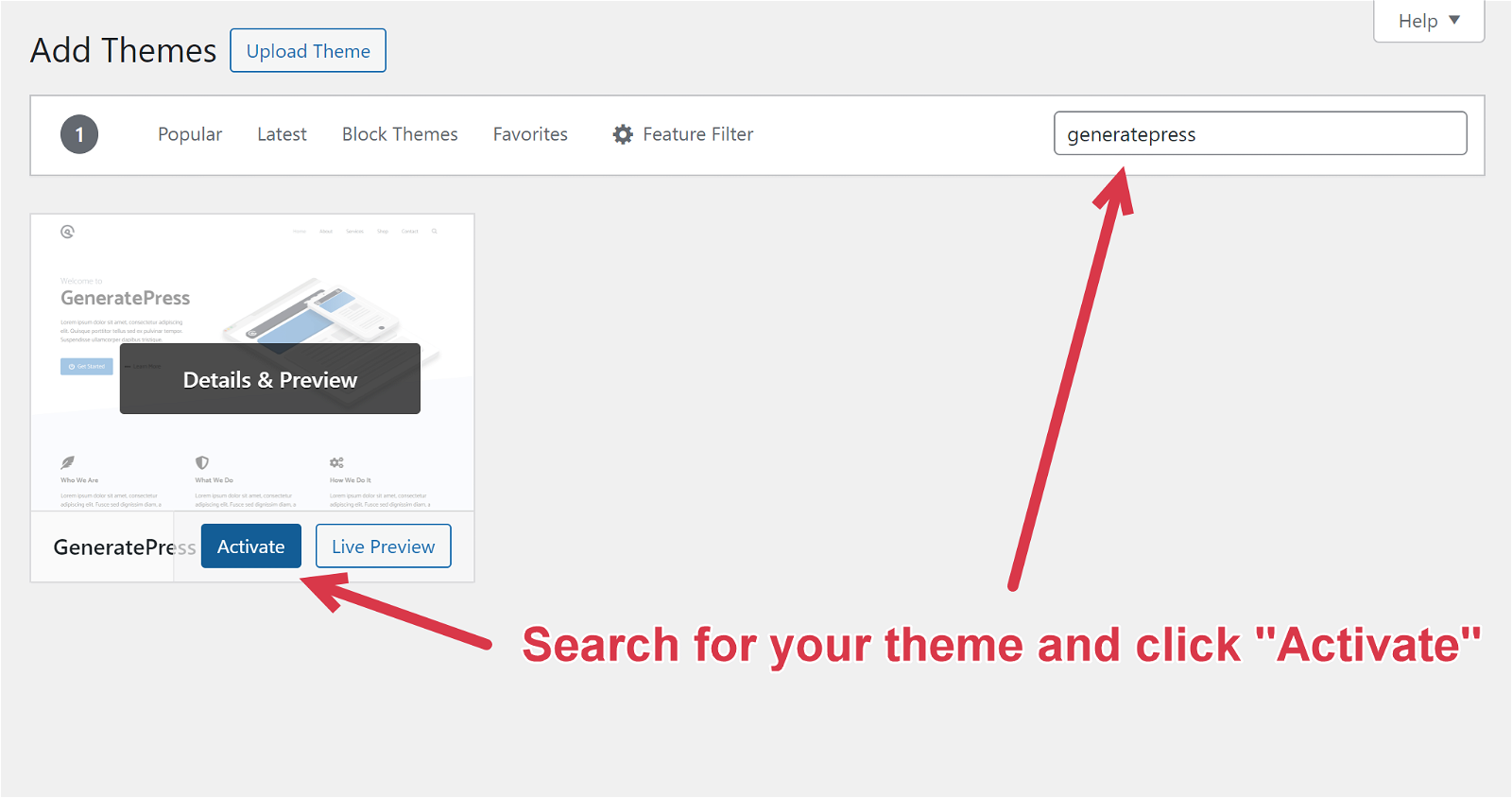
That’s all there is to it! Now that you have a WordPress theme installed, you can start customizing your website and adding some personal touches.
6 Decide on Design & Branding
The WordPress theme you chose gives you a basic design framework, but now it’s time to fine-tune your design to match your branding.
Your design choices are fundamental to how visitors perceive your home decor blog, so this is a crucial step. We’ll focus on two essentials – your color palette and logo.
Your design choices should be an extension of your niche. For example, a blog that delves into rustic or farmhouse decor might use warm, earthy tones like deep reds, forest greens, and browns. These colors can be paired with design elements that mimic natural materials, like wood textures or stone patterns.
To get started, you need to lay out the color palette for your site. You don’t have any design experience to choose colors that work for your blog. You can simply use Coolors to create a palette of colors that work perfectly together.
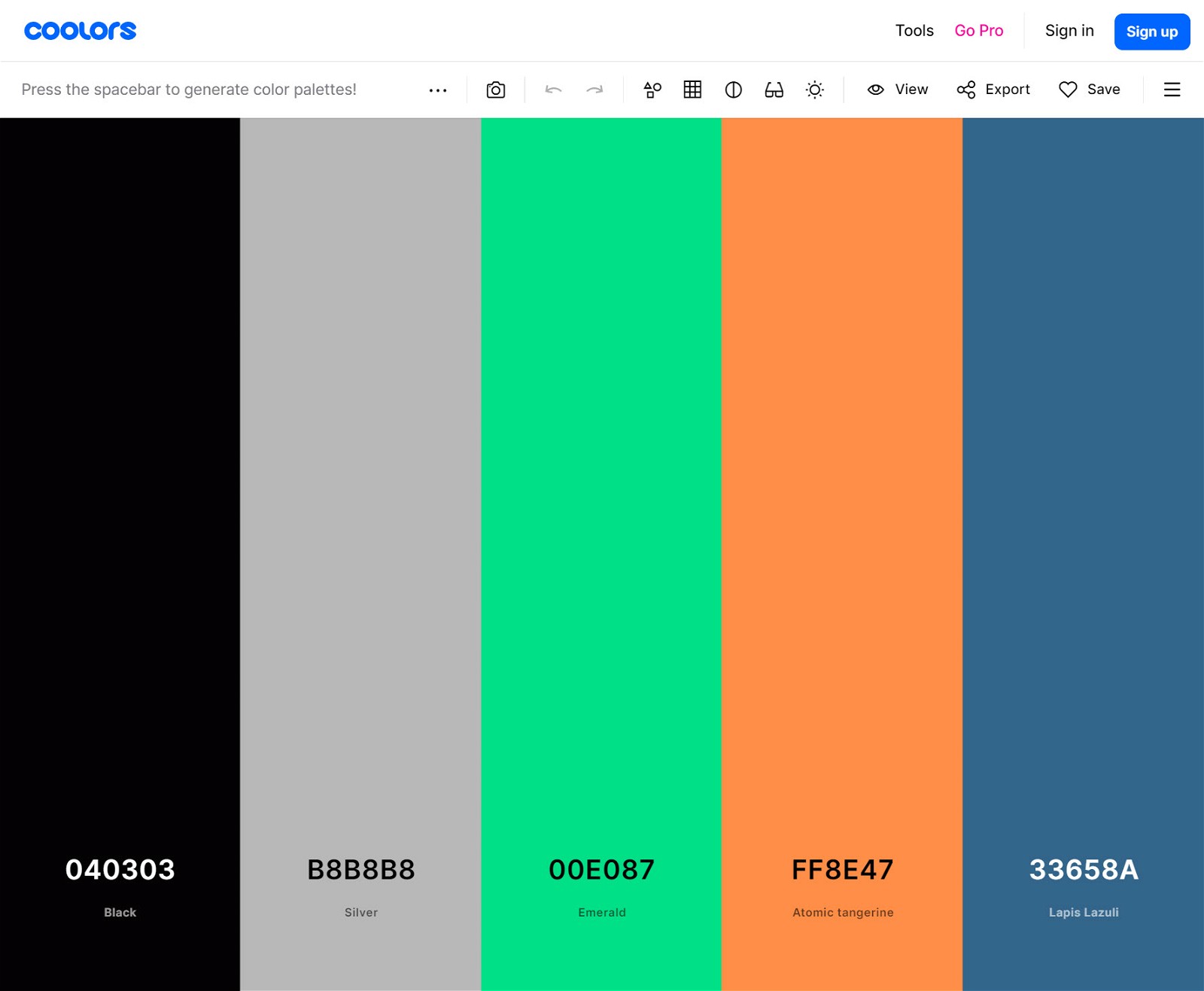
Once you’ve chosen your colors, you need to create your site logo.
The logo sets the tone for your whole site, and it’s often the first thing visitors see. If you get it right, it’s one of the things about your brand that sticks in their minds, too!
Like the colors, your logo should match your brand and niche. For example, many home decorating blog logos use simple text on a white background. Scripted fonts are popular in this niche, too.
Even if you’ve never designed a logo before, you can use a Canva logo template that matches your website’s look and feel to get started. Then, you can customize it to fit your brand colors and home decor blog name.
Here are some Canva templates for home decor logos:

7 Create Essential Pages
Your blog is really starting to take shape, so it’s time to add some essential pages. Every blog needs these, so don’t leave any of them out!
Homepage
This is the main landing page of your website. It should immediately let visitors know what your site is all about and make it easy to find what they’re looking for.
About Page
Here is where you can share your background and expertise with home decor. Explain why you started your blog and what you want to accomplish with it. Use personal stories, talk about your favorite decorating projects, and maybe include a picture or two to make this page relatable and inviting.
Contact Page
This is where you let your readers know how to get in touch with you. This page should include a contact form, email address, and links to any decor-related social media accounts you have.
Privacy Policy + Terms & Conditions Pages
These are two required legal pages that explain what information you collect from users and dictate how visitors can use your site. You can generate both of these pages at PrivacyPolicies.com.
It’s easy to create a new WordPress page. Log in to your dashboard, click the “Pages” menu, and then choose “Add New.”
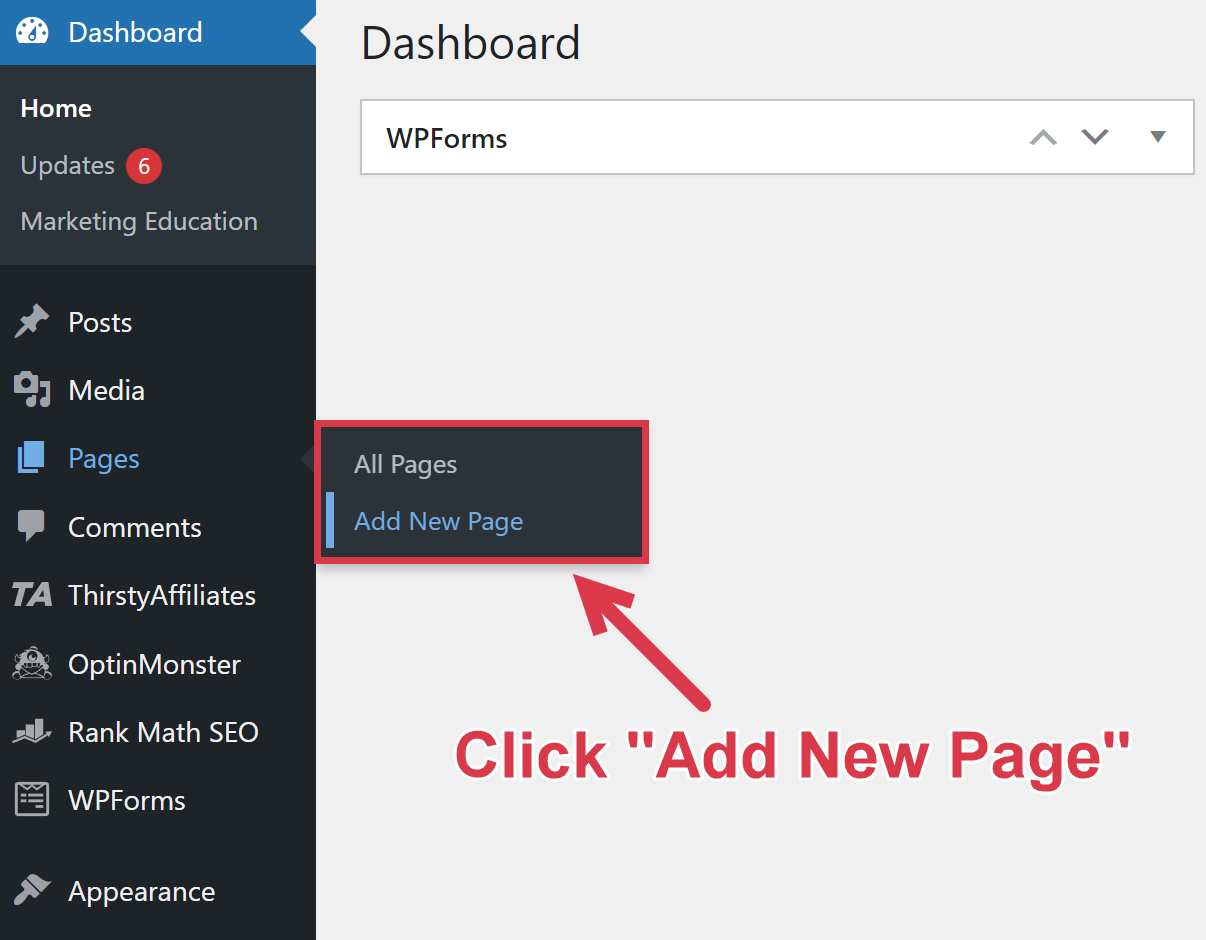
8 Start Creating Content
You’ve done a ton of work to set up your home decor blog, and now it’s time to get into the fun stuff. You finally get to start writing about home decor!
While it’s tempting to start writing about the first home decor topics that come to mind, I recommend using a keyword-focused content strategy to ensure you’re writing about topics that will generate traffic.
The goal of this approach is to identify phrases people are searching for on search engines like Google and then write content that answers their queries.
The best way to implement a keyword-focused strategy is to find low-competition keywords with decent monthly search volume. You don’t want to target the highest-traffic keywords because it will be hard for your new blog to rank against the high competition from established home decor websites.
Ahrefs is the best tool for finding keywords in this sweet spot.
Just type a “seed keyword” into the Ahrefs Keyword Explorer, which will spit out relevant related terms and their estimated search volumes.
For example, if you type “rustic home decor” into Ahrefs, you get the following matching terms:
| Keyword | Search Volume | Keyword Difficulty |
|---|---|---|
| rustic home decor ideas | 600 | 22 |
| modern rustic home decor | 200 | 22 |
| rustic country home decor | 150 | 12 |
| rustic farmhouse style home decor | 150 | 26 |
| rustic western home decor | 150 | 10 |
| diy rustic home decor | 70 | 8 |
Use this keyword research strategy to plan out your first 10 blog posts. Here are some awesome post ideas from the keyword results above:
- “5 Must-Try DIY Rustic Home Decor Ideas for Beginners”
- “Top 10 Western Home Decor Ideas for New Homeowners”
- “25 Rustic Home Decor Catalogs for All Your Design Needs”
Now that you have some great post titles based on keyword research, it’s time to start writing.
Here are some tips to help you write SEO-focused blog posts that will hit home with your target decor audience:
- Stay on topic. Each blog post you write needs to meet the search intent of the target keyword. If you wander too far from what searchers want to read about, your post won’t get much traffic.
- Showcase before and after transformations. Feature before and after photos of your home decor projects. This can visually demonstrate the impact of your decorating tips and inspire readers.
- Collaborate with interior designers and experts. Feature guest posts and interviews from interior designers or home decor experts.
- Write with emotion. You’re passionate about home decor, so make sure that enthusiasm comes through in your writing. No boring, robotic text for your readers!
- Use images and other visuals. Interesting images and graphics can spice up your post and help you get your point across. They also break up the text and keep the reader moving down the page. Pictures of real projects you’ve completed can be especially powerful for making a home decorating blog come to life.
- Use visual platforms for ideas and images. Home decor is very visual – platforms like Pinterest and Instagram can give you an idea of what’s creating a stir with your target audience. You can even embed images and videos from these platforms to spice up your posts.
- Cover events and seasons. Decorating events like the Toronto Fall Home Show are always a big deal, and you can create some great content by covering the festivities. Decor blogs can take advantage of the seasons, too – you can plan out different types of content for spring, summer, fall, winter, the holidays, etc.
Ultimately, the success of your blog will depend on writing plenty of high-quality, search-focused posts. Take the time you need to make your content as valuable as possible for your target audience.
9 Promote Your Home Decor Blog
Even though you won’t get far without top-notch content, writing is just the first step in ensuring each post succeeds.
You also need to be smart and diligent in building a promotion strategy to get your post in front of as many readers as possible as quickly as possible.
Here are some excellent promotional strategies to help increase the reach of your home decorating blog:
Share posts in home decor communities: You can get a lot of eyeballs on your content by posting on decorating forums – just be sure you share your expertise and add real value.
The decor community also has a strong presence on social media. The #homedecor tag has 140M+ posts on Instagram, for instance, and some accounts have thousands or even millions of followers. Decorating is also one of the most popular niches on Pinterest and in Facebook groups.
Build an email list: Ask visitors to sign up for your email list in exchange for a decor-focused freebie, like a checklist about completing a particular project. Then, email your list when you publish new content or have something interesting to share.
Collaborate with other decorators and home decor bloggers: When you partner with decorators or another home decor blogger to promote each other’s content, you get access to a whole new set of readers.
This approach works well with complementary sub-niches. For example, a rustic decor blog could collaborate with a blog focused on antiques or DIY. You could also partner with YouTubers who have engaged decor audiences.
Set up a booth at a craft fair. You can showcase pictures of your work along with selling some of your designs or creations. Make sure your logo and blog URL are prominently displayed!
Give away a free design session. You could create a giveaway to help a local homeowner with one of their design projects and promote it on Facebook among friends and the local groups you participate in.
Enter local contests. Many county fairs and local festivals have contests for crafts and other decor-based projects. Enter some of your creations and mingle with the crowd while they check out your work.
10 Monetize Your Home Decor Blog
Whew! After all the work you’ve put into your blog to reach this point, it’s finally time to make some money!
Here are three ways you can monetize your home decorating blog without causing a lot of grief for your readers:
Affiliate Marketing
Recommend home decor materials, design software, and guides or books that you love.
Why It’s Great: You can start making money immediately, even if you don’t have much traffic yet. Plus, you get to help your audience by recommending products they can use in their decor projects.
Get Started: Check out our guide on how to start affiliate marketing and our list of the best home decor affiliate programs.
Display Ads
Show ads on your blog through ad networks or direct sponsorships
Why It’s Great: You make money for every visitor to your blog, even if they don’t buy anything. Plus, ads align well with your content and your audience’s interests.
Get Started: Sign up for the Ezoic ad network, which we recommend over Google Adsense. You can also negotiate direct sponsorships, which offer more control and potential profit.
Sell Your Own Products
You can make money directly from your expertise by selling digital products like decorating guides, woodworking tutorials, or even physical creations related to your home decor content.
Why It’s Great: You get to tailor your offering to your audience’s needs and show off your experience and expertise while keeping all the profits.
Get Started: Identify what your audience needs or wants to know and figure out how to deliver it. For example, beginning decorators might want tips on saving money or video tutorials on some simple woodworking projects. Platforms like Etsy for physical goods or Teachable for courses can be excellent starting points.
Summing Up
We’ve covered the essential steps of starting a home decor blog, but there’s so much more I didn’t have room to share.
Blogging has a high learning curve, and there’s a ton of powerful information this post doesn’t cover.
That’s why we’ve created comprehensive free training for new bloggers. This training video teaches you 7 hard-won tactics we’ve learned over our 10+ years of blog-building that will make your new home decor blog 83% more successful.
If you’re serious about creating a successful blog, this is the next step.
FAQs
Blogs focused on home decor can be profitable – in fact, the average home decor blog earns more than $5,000 per month, according to our affiliate marketing statistics.
You can turn your passion for home decor into a successful blog venture by leveraging affiliate marketing, display ads, and selling unique products.
1. Niche down – find a main focus and go all-in on that sub-niche.
2. Get hosting – we recommend SiteGround.
3. Set up a self-hosted WordPress blog.
4. Set up a niche-specific theme and style.
5. Focus on keyword research and write great content to meet searcher intent.
6. Share posts on social media and with decor communities.










